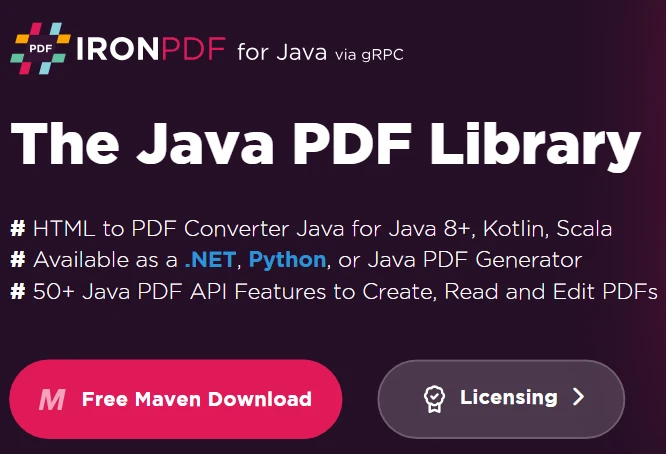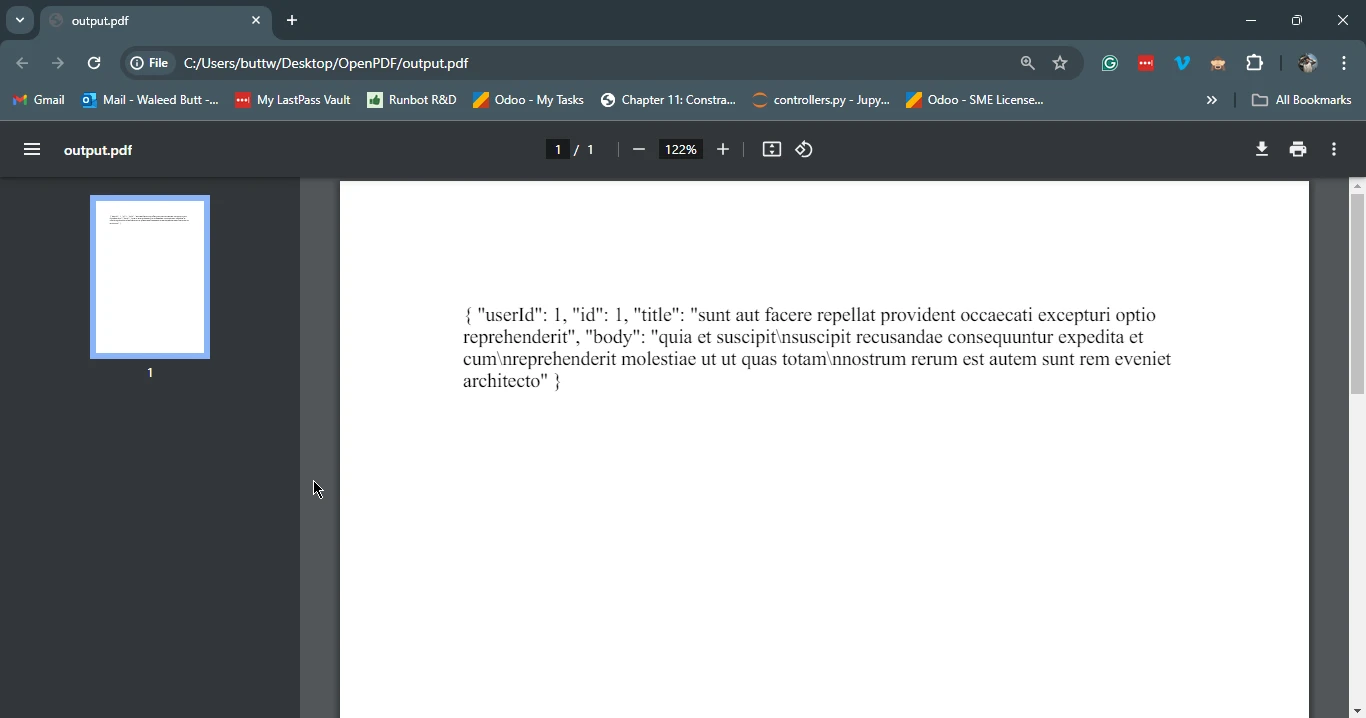Test in production without watermarks.
Works wherever you need it to.
Get 30 days of fully functional product.
Have it up and running in minutes.
Full access to our support engineering team during your product trial
The Google HTTP Client Library for Java is a robust library designed to simplify the process of making HTTP requests and handling responses in Java applications. It is a part of the Google app engine and Google API client as part of the Google Apis. Developed and maintained by Google, this powerful Java library supports a wide range of HTTP methods and integrates seamlessly with JSON data models and XML data models, making it an excellent choice for developers looking to interact with web services. Additionally, we'll explore IronPDF for Java and demonstrate how to integrate it with Google HTTP Client Library to generate PDF documents from HTTP Response data.
Built-in Retry Mechanism: The library includes a built-in retry mechanism for handling transient network errors, which can help improve applications' robustness.

To use the Google HTTP Client Library for Java, you must add the full client library and necessary dependencies to your project. If you are using Maven, you can add the following dependencies to your pom.xml file:
<dependencies>
<dependency>
<groupId>com.google.http-client</groupId>
<artifactId>google-http-client</artifactId>
<version>1.39.2</version>
</dependency>
<dependency>
<groupId>com.google.http-client</groupId>
<artifactId>google-http-client-jackson2</artifactId>
<version>1.39.2</version>
</dependency>
</dependencies>Let's explore the basic usage of the Google HTTP Client Library for Java through various examples.
The following code demonstrates how to make a full request content simple GET request using the Google HTTP Client Library:
import com.google.api.client.http.HttpRequest;
import com.google.api.client.http.HttpRequestFactory;
import com.google.api.client.http.HttpResponse;
import com.google.api.client.http.javanet.NetHttpTransport;
import com.google.api.client.http.GenericUrl;
public class HttpClientExample {
public static void main(String[] args) {
try {
HttpRequestFactory requestFactory = new NetHttpTransport().createRequestFactory();
GenericUrl url = new GenericUrl("https://jsonplaceholder.typicode.com/posts/1");
HttpRequest request = requestFactory.buildGetRequest(url);
HttpResponse response = request.execute();
System.out.println(response.parseAsString());
} catch (Exception e) {
e.printStackTrace();
}
}
}In this example, we create an HttpRequestFactory and use it to build and execute a GET request to a placeholder API. We use a try-catch block here to reduce the frequency of a compilation error by catching the exception in the event the request fails. We then print the response to the console shown below.

The following code demonstrates how to make a POST request with JSON data:
import com.google.api.client.http.HttpRequest;
import com.google.api.client.http.HttpRequestFactory;
import com.google.api.client.http.HttpResponse;
import com.google.api.client.http.javanet.NetHttpTransport;
import com.google.api.client.http.GenericUrl;
import com.google.api.client.http.json.JsonHttpContent;
import com.google.api.client.json.JsonFactory;
import com.google.api.client.json.jackson2.JacksonFactory;
import java.util.HashMap;
import java.util.Map;
public class HttpClientExample {
public static void main(String[] args) {
try {
HttpRequestFactory requestFactory = new NetHttpTransport().createRequestFactory();
GenericUrl url = new GenericUrl("https://jsonplaceholder.typicode.com/posts");
Map<String, Object> jsonMap = new HashMap<>();
jsonMap.put("title", "foo");
jsonMap.put("body", "bar");
jsonMap.put("userId", 1);
JsonFactory jsonFactory = new JacksonFactory();
JsonHttpContent content = new JsonHttpContent(jsonFactory, jsonMap);
HttpRequest request = requestFactory.buildPostRequest(url, content);
HttpResponse response = request.execute();
System.out.println(response.parseAsString());
} catch (Exception e) {
e.printStackTrace();
}
}
}In this example, we create a JSON object and use JsonHttpContent to send it in a POST request. The response is then printed to the console.

IronPDF is a powerful library for Java developers that simplifies the process of creating, editing, and managing PDF documents. It provides a wide range of features, including converting HTML to PDF, manipulating existing PDF files, and extracting text and images from PDFs.

To use IronPDF in your Java project, you need to include the IronPDF library. You can download the JAR file from the IronPDF website or use a build tool like Maven to include it in your project. For users using Maven, add the following code to your pom.xml:
<!--Adds IronPDF Java. Use the latest version in the version tag.-->
<dependency>
<groupId>com.ironsoftware</groupId>
<artifactId>ironpdf</artifactId>
<version>2023.12.1</version>
</dependency>
<!--Adds the slf4j logger which IronPDF Java uses.-->
<dependency>
<groupId>org.slf4j</groupId>
<artifactId>slf4j-simple</artifactId>
<version>2.0.3</version>
</dependency>In this section, we will demonstrate how to use the Google HTTP Client Library to fetch HTML content from a web service and then use IronPDF to convert that HTML content into a PDF document.
import com.google.api.client.http.HttpRequest;
import com.google.api.client.http.HttpRequestFactory;
import com.google.api.client.http.HttpResponse;
import com.google.api.client.http.javanet.NetHttpTransport;
import com.google.api.client.http.GenericUrl;
import com.google.api.client.json.JsonFactory;
import com.google.api.client.json.jackson2.JacksonFactory;
import com.google.api.client.http.json.JsonHttpContent;
import com.google.api.client.auth.oauth2.Credential;
import com.google.api.client.auth.oauth2.CredentialAccessMethod;
import com.google.api.client.auth.oauth2.TokenResponse;
import com.google.api.client.auth.oauth2.TokenResponseException;
import com.google.api.client.auth.oauth2.TokenRequest;
import com.google.api.client.auth.oauth2.AuthorizationCodeFlow;
import com.google.api.client.auth.oauth2.AuthorizationCodeRequestUrl;
import com.google.api.client.auth.oauth2.AuthorizationCodeTokenRequest;
import com.google.api.client.auth.oauth2.ClientParametersAuthentication;
import com.google.api.client.json.JsonGenerator;
import java.io.IOException;
import java.util.HashMap;
import java.util.Map;
import com.ironsoftware.ironpdf.PdfDocument;
public class HtmlToPdfExample {
public static void main(String[] args) {
try {
// Fetch HTML content using Google HTTP Client Library
HttpRequestFactory requestFactory = new NetHttpTransport().createRequestFactory();
GenericUrl url = new GenericUrl("https://jsonplaceholder.typicode.com/posts/1");
HttpRequest request = requestFactory.buildGetRequest(url);
HttpResponse response = request.execute();
String htmlContent = response.parseAsString();
// Convert HTML content to PDF using IronPDF
PdfDocument pdf = PdfDocument.renderHtmlAsPdf(htmlContent);
pdf.saveAs("output.pdf");
System.out.println("PDF created successfully!");
} catch (Exception e) {
e.printStackTrace();
}
}
}In this example, we first fetch HTML content from a placeholder API using the Google HTTP Client Library. We then use IronPDF to convert the fetched HTML content into a PDF document and save it as output.pdf.

The Google HTTP Client Library for Java is a powerful tool for interacting with web services, offering simplified HTTP requests, support for various authentication methods, seamless integration with JSON and XML parsing, and compatibility for various Java environments. Combined with IronPDF, developers can easily fetch HTML content from web services and convert it into PDF documents, enabling a full library for various applications, from generating reports to creating downloadable content for web applications. By leveraging these two libraries, Java developers can significantly enhance the capabilities of their applications while reducing the complexity of code.
Please refer to the following link.